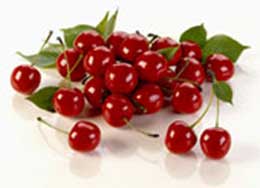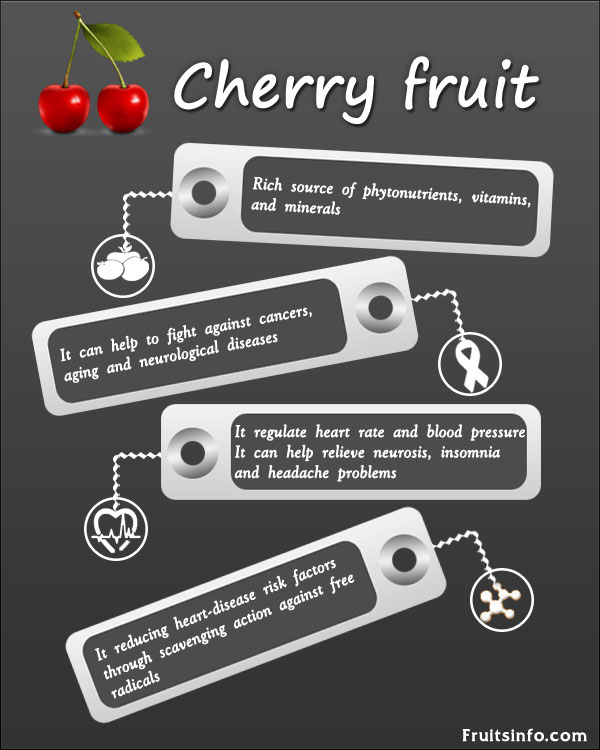 Full List of Fruits
Full List of Fruits  Cherry fruit
Cherry fruit Cherries

The standard for pie cherries. Medium large, bright red fruit with firm yellow flesh. Rich, tart, tangy flavor. Tree grows to 15' tall. Self-fertile.Large fruited Morello type with thin, light red skin, red flesh, red juice with small freestone. Fruit will turn mahogany if left on the tree. Crack resistant. A natural dwarf tree 6-12' tall.
Nutrition Information of Cherries
Principle |
Nutrient Value per 100g |
Percentage of RDA |
||||
Cherry type |
|
|
||||
Energy |
63 cal 50 Kcal |
3% 2.5% |
||||
Carbohydrates |
16.1 g 12.18 g |
12% 9% |
||||
Protein |
1.06 g 1.00 g |
2% 2% |
||||
Total Fat |
0.2 g 0.3 g |
1% 1.5% |
||||
Cholesterol |
0 g 0 g |
0% 0% |
||||
Dietary Fiber |
2.1 g 1.6 g |
5.5% 4% |
||||
Vitamins |
||||||
Folates |
4 µg 8 µg |
1% 2% |
||||
Niacin |
0.154 mg 0.400 mg |
1% 2.5% |
||||
Pantothenic acid |
0.199 mg 0.143 mg |
4% 3% |
||||
Pyridoxine |
0.049 mg 0.044 mg |
4% 3.5% |
||||
Riboflavin |
0.033 mg 0.040 mg |
2.5% 3% |
||||
Thiamin |
0.027 mg 0.030 mg |
2% 2.5% |
||||
Vitamin C |
7 mg 10 mg |
11% 17% |
||||
Vitamin A |
640IU 1283 IU |
21% 43% |
||||
Vitamin E |
0.07 mg 0.07 mg |
0.5% 0.5% |
||||
Vitamin K |
2.1 µg 2.1 µg |
2% 2% |
||||
Electrolytes |
||||||
Sodium |
0 mg 3mg |
0% 0% |
||||
Potassium |
222 mg 179mg |
5% 4% |
||||
Minerals |
||||||
Calcium |
13 mg 16 mg |
1.3% 1.6% |
||||
Copper |
0.060 mg 0.104 mg |
7% 11.5% |
||||
Iron |
0.36 mg 0.32 mg |
4.5% 4% |
||||
Magnesium |
11 mg 9mg |
3% 2% |
||||
Manganese |
0.070 mg 0.112mg |
3% 5% |
||||
Phosphorus |
21 mg 15 mg |
3% 2% |
||||
Zinc |
0.07 mg 0.10 mg |
0.5% 0.1% |
About Cherries:
How to buy fresh Cherries?
Look for: A very dark color is your most important indication of good flavor and maturity in sweet cherries. Bing, Black Tartarian, Schmidt, Chapman, and Republican varieties should range from deep maroon or mahogany red to black for richest flavor. Lambert cherries should be dark red. Rainier cherries should be straw-colored. Good cherries have bright, glossy, plump-looking surfaces and fresh-looking stems.
Avoid: Overmature cherries lacking in flavor, indicated by shrivelling, dried stems, and a generally dull appearance. Decay is fairly common at times on sweet cherries, but because of the normal dark color, decayed areas are often inconspicuous. Soft, leaking flesh, brown discoloration, and mold growth are indications of decay.
















